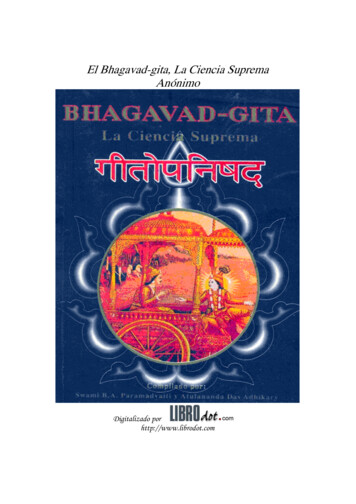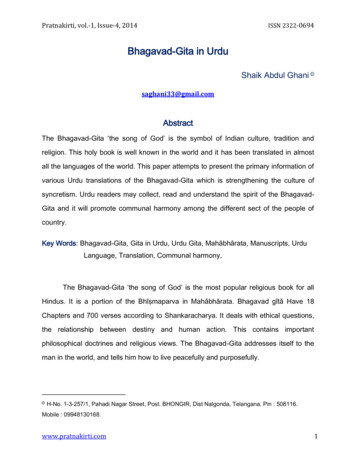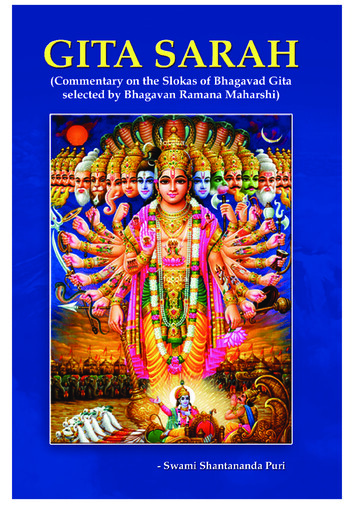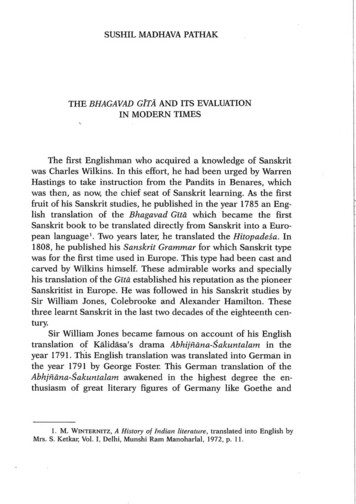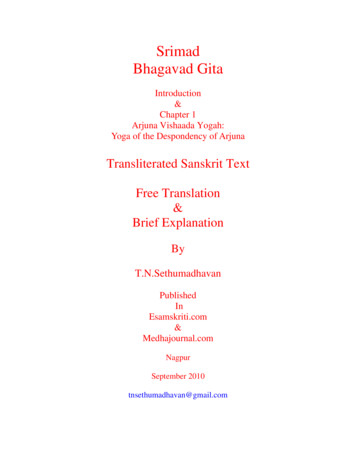
Transcription
“Bhagavad-gita As It Is” by His Divine Grace A.C. Bhaktivedanta SwamiPrabhupada.COPYRIGHT NOTICE: This is an evaluation copy of the printed version ofthis book, and is NOT FOR RESALE. This evaluation copy is intended forpersonal non-commercial use only, under the “fair use” guidelinesestablished by international copyright laws. You may use thiselectronic file to evaluate the printed version of this book, for yourown private use, or for short excerpts used in academic works,research, student papers, presentations, and the like. You candistribute this evaluation copy to others over the Internet, so long asyou keep this copyright information intact. You may not reproduce morethan ten percent (10%) of this book in any media without the expresswritten permission from the copyright holders. Reference any excerptsin the following way: “Excerpted from “Bhagavad-gita As It Is” by A.C.Bhaktivedanta Swami Prabhupada, courtesy of the Bhaktivedanta BookTrust International, www.Krishna.com.”This book and electronic file is Copyright 1972-2003 Bhaktivedanta BookTrust International, 3764 Watseka Avenue, Los Angeles, CA 90034, USA.All rights reserved. For any questions, comments, correspondence, or toevaluate dozens of other books in this collection, visit the website ofthe publishers, www.Krishna.com.!
Chapter(22) 11 - The Universal Form Translations 1-55(23)Chapter(24) 12 - Devotional Service Translations 1-20(25)Chapter(26) 13 - Nature, the Enjoyer, and Consciousness Translations 1-35(27)Chapter(28) 14 - The Three Modes of Material Nature Translations 1-27(29)Chapter(30) 15 - The Yoga of the Supreme Person Translations 1-20(31)Chapter(32) 16 - The Divine and Demoniac Natures Translations 1-24(33)Chapter(34) 17 - The Divisions of Faith Translations 1-28(35)Chapter(36) 18 - Conclusion-The Perfection of Renunciation Translations 1-78(37)Setting the SceneAlthough widely published and read by itself, Bhagavad-gétä originallyappears as an episode in the Mahäbhärata, the epic Sanskrit history of theancient world. The Mahäbhärata tells of events leading up to the present Ageof Kali. It was at the beginning of this age, some fifty centuries ago, that LordKåñëa spoke Bhagavad-gétä to His friend and devotee Arjuna.Their discourse—one of the greatest philosophical and religious dialoguesknown to man—took place just before the onset of war, a great fratricidal2
conflict between the hundred sons of Dhåtaräñöra and on the opposing sidetheir cousins the Päëòavas, or sons of Päëòu.Dhåtaräñtra and Päëòu were brothers born in the Kuru dynasty, descendingfrom King Bharata, a former ruler of the earth, from whom the nameMahäbhärata derives. Because Dhåtaräñöra, the elder brother, was born blind,the throne that otherwise would have been his was passed down to the youngerbrother, Päëòu.When Päëòu died at an early age, his five children—Yudhiñöhira, Bhéma,Arjuna, Nakula and Sahadeva—came under the care of Dhåtaräñöra, who ineffect became, for the time being, the king. Thus the sons of Dhåtaräñöra andthose of Päëòu grew up in the same royal household. Both were trained in themilitary arts by the expert Droëa and counseled by the revered “grandfather”of the clan, Bhéñma. Yet the sons of Dhåtaräñöra, especially the eldest,Duryodhana, hated and envied the Päëòavas. And the blind and weak-mindedDhåtaräñöra wanted his own sons, not those of Päëòu, to inherit the kingdom.Thus Duryodhana, with Dhåtaräñöra’s consent, plotted to kill the young sonsof Päëòu, and it was only by the careful protection of their uncle Vidura andtheir cousin Lord Kåñëa that the Päëòavas escaped the many attempts againsttheir lives.Now, Lord Kåñëa was not an ordinary man but the Supreme GodheadHimself, who had descended to earth and was playing the role of a prince in acontemporary dynasty. In this role He was also the nephew of Päëòu’s wifeKunté, or Påthä, the mother of the Päëòavas. So both as a relative and as theeternal upholder of religion, Kåñëa favored the righteous sons of Päëòu andprotected them.Ultimately, however, the clever Duryodhana challenged the Päëòavas to agambling match. In the course of that fateful tournament, Duryodhana and hisbrothers took possession of Draupadé, the chaste and devoted wife of thePäëòavas, and insultingly tried to strip her naked before the entire assembly ofprinces and kings. Kåñëa’s divine intervention saved her, but the gambling,3
which was rigged, cheated the Päëòavas of their kingdom and forced them intothirteen years of exile.Upon returning from exile, the Päëòavas rightfully requested their kingdomfrom Duryodhana, who bluntly refused to yield it. Dutybound as princes toserve in public administration, the five Päëòavas reduced their request to amere five villages. But Duryodhana arrogantly replied that he wouldn’t sparethem enough land into which to drive a pin.Throughout all this, the Päëòavas had been consistently tolerant andforbearing. But now war seemed inevitable.Nonetheless, as the princes of the world divided, some siding with the sonsof Dhåtaräñöra, others with the Päëòavas, Kåñëa Himself took the role ofmessenger for the sons of Päëòu and went to the court of Dhåtaräñöra to pleadfor peace. When His pleas were refused, war was now certain.The Päëòavas, men of the highest moral stature, recognized Kåñëa to be theSupreme Personality of Godhead, whereas the impious sons of Dhåtaräñöra didnot. Yet Kåñëa offered to enter the war according to the desire of theantagonists. As God, He would not personally fight; but whoever so desiredmight avail himself of Kåñëa’s army—and the other side could have KåñëaHimself, as an advisor and helper. Duryodhana, the political genius, snatchedat Kåñëa’s armed forces, while the Päëòavas were equally eager to have KåñëaHimself.In this way, Kåñëa became the charioteer of Arjuna, taking it upon Himselfto drive the fabled bowman’s chariot. This brings us to the point at whichBhagavad-gétä begins, with the two armies arrayed, ready for combat, andDhåtaräñöra anxiously inquiring of his secretary Saïjaya, “What did they do?”The scene is set, with only the need for a brief note regarding thistranslation and commentary.The general pattern translators have followed in rendering Bhagavad-gétä4
into English has been to brush aside the person Kåñëa to make room for theirown concepts and philosophies. The history of the Mahäbhärata is taken asquaint mythology, and Kåñëa becomes a poetic device for presenting the ideasof some anonymous genius, or at best He becomes a minor historical personage.But the person Kåñëa is both the goal and the substance of Bhagavad-gétä, so faras the Gétä speaks of itself.This translation, then, and the commentary that accompanies it propose todirect the reader to Kåñëa rather than away from Him. The Bhagavad-gétä thusbecomes wholly consistent and comprehensible. Since Kåñëa is the speaker ofthe Gétä, and its ultimate goal as well, the Bhagavad-gétä As It Is thus presentsthis great scripture in its true terms.—The PublishersDedicationToÇRÉLA BALADEVA VIDYÄBHÜÑAËAwho presented so nicelythe "Govinda-bhäñya" commentaryonVedänta philosophyPrefaceOriginally I wrote Bhagavad-gétä As It Is in the form in which it is presentednow. When this book was first published, the original manuscript was,unfortunately, cut short to less than 400 pages, without illustrations andwithout explanations for most of the original verses of the ÇrémadBhagavad-gétä. In all of my other books—Çrémad-Bhägavatam, Çré Éçopaniñad,5
etc.—the system is that I give the original verse, its English transliteration,word-for-word Sanskrit-English equivalents, translations and purports. Thismakes the book very authentic and scholarly and makes the meaningself-evident. I was not very happy, therefore, when I had to minimize myoriginal manuscript. But later on, when the demand for Bhagavad-gétä As It Isconsiderably increased, I was requested by many scholars and devotees topresent the book in its original form. Thus the present attempt is to offer theoriginal manuscript of this great book of knowledge with full paramparäexplanation in order to establish the Kåñëa consciousness movement moresoundly and progressively.Our Kåñëa consciousness movement is genuine, historically authorized,natural and transcendental due to its being based on Bhagavad-gétä As It Is. Itis gradually becoming the most popular movement in the entire world,especially amongst the younger generation. It is becoming more and moreinteresting to the older generation also. Older gentlemen are becominginterested, so much so that the fathers and grandfathers of my disciples areencouraging us by becoming life members of our great society, theInternational Society for Krishna Consciousness. In Los Angeles many fathersand mothers used to come to see me to express their feelings of gratitude for myleading the Kåñëa consciousness movement throughout the entire world. Someof them said that it is greatly fortunate for the Americans that I have startedthe Kåñëa consciousness movement in America. But actually the originalfather of this movement is Lord Kåñëa Himself, since it was started a very longtime ago but is coming down to human society by disciplic succession. If I haveany credit in this connection, it does not belong to me personally, but it is dueto my eternal spiritual master, His Divine Grace Oà Viñëupäda ParamahaàsaParivräjakäcärya 108 Çré Çrémad Bhaktisiddhänta Sarasvaté Gosvämé MahäräjaPrabhupäda.If personally I have any credit in this matter, it is only that I have tried topresent Bhagavad-gétä as it is, without any adulteration. Before mypresentation of Bhagavad-gétä As It Is, almost all the English editions of6
Bhagavad-gétä were introduced to fulfill someone's personal ambition. But ourattempt, in presenting Bhagavad-gétä As It Is, is to present the mission of theSupreme Personality of Godhead, Kåñëa. Our business is to present the will ofKåñëa, not that of any mundane speculator like the politician, philosopher orscientist, for they have very little knowledge of Kåñëa, despite all their otherknowledge. When Kåñëa says, man-manä bhava mad-bhakto mad-yäjé mäànamaskuru [Bg. 18.65], etc., we, unlike the so-called scholars, do not say thatKåñëa and His inner spirit are different. Kåñëa is absolute, and there is nodifference between Kåñëa's name, Kåñëa's form, Kåñëa's qualities, Kåñëa'spastimes, etc. This absolute position of Kåñëa is difficult to understand for anyperson who is not a devotee of Kåñëa in the system of paramparä (disciplicsuccession). Generally the so-called scholars, politicians, philosophers, andsvämés, without perfect knowledge of Kåñëa, try to banish or kill Kåñëa whenwriting commentary on Bhagavad-gétä. Such unauthorized commentary uponBhagavad-gétä is known as Mäyäväda-bhäñya, and Lord Caitanya has warned usabout these unauthorized men. Lord Caitanya clearly says that anyone whotries to understand Bhagavad-gétä from the Mäyävädé point of view will commita great blunder. The result of such a blunder will be that the misguided studentof Bhagavad-gétä will certainly be bewildered on the path of spiritual guidanceand will not be able to go back to home, back to Godhead.Our only purpose is to present this Bhagavad-gétä As It Is in order to guidethe conditioned student to the same purpose for which Kåñëa descends to thisplanet once in a day of Brahmä, or every 8,600,000,000 years. This purpose isstated in Bhagavad-gétä, and we have to accept it as it is; otherwise there is nopoint in trying to understand the Bhagavad-gétä and its speaker, Lord Kåñëa.Lord Kåñëa first spoke Bhagavad-gétä to the sun-god some hundreds of millionsof years ago. We have to accept this fact and thus understand the historicalsignificance of Bhagavad-gétä, without misinterpretation, on the authority ofKåñëa. To interpret Bhagavad-gétä without any reference to the will of Kåñëa isthe greatest offense. In order to save oneself from this offense, one has tounderstand the Lord as the Supreme Personality of Godhead, as He was7
directly understood by Arjuna, Lord Kåñëa's first disciple. Such understandingof Bhagavad-gétä is really profitable and authorized for the welfare of humansociety in fulfilling the mission of life.The Kåñëa consciousness movement is essential in human society, for itoffers the highest perfection of life. How this is so is explained fully in theBhagavad-gétä. Unfortunately, mundane wranglers have taken advantage ofBhagavad-gétä to push forward their demonic propensities and mislead peopleregarding right understanding of the simple principles of life. Everyone shouldknow how God, or Kåñëa, is great, and everyone should know the factualposition of the living entities. Everyone should know that a living entity iseternally a servant and that unless one serves Kåñëa one has to serve illusion indifferent varieties of the three modes of material nature and thus wanderperpetually within the cycle of birth and death; even the so-called liberatedMäyävädé speculator has to undergo this process. This knowledge constitutes agreat science, and each and every living being has to hear it for his owninterest.People in general, especially in this Age of Kali, are enamored by theexternal energy of Kåñëa, and they wrongly think that by advancement ofmaterial comforts every man will be happy. They have no knowledge that thematerial or external nature is very strong, for everyone is strongly bound by thestringent laws of material nature. A living entity is happily the part and parcelof the Lord, and thus his natural function is to render immediate service to theLord. By the spell of illusion one tries to be happy by serving his personal sensegratification in different forms which will never make him happy. Instead ofsatisfying his own personal material senses, he has to satisfy the senses of theLord. That is the highest perfection of life. The Lord wants this, and Hedemands it. One has to understand this central point of Bhagavad-gétä. OurKåñëa consciousness movement is teaching the whole world this central point,and because we are not polluting the theme of Bhagavad-gétä As It Is, anyoneseriously interested in deriving benefit by studying the Bhagavad-gétä musttake help from the Kåñëa consciousness movement for practical understanding8
of Bhagavad-gétä under the direct guidance of the Lord. We hope, therefore,that people will derive the greatest benefit by studying Bhagavad-gétä As It Is aswe have presented it here, and if even one man becomes a pure devotee of theLord, we shall consider our attempt a success.A.C. Bhaktivedanta Swami12 May, 1971Sydney, AustraliaIntroductionoà akñur unmélitaà yenatasmai çré-gurave namaùçré-caitanya-mano-'bhéñöaàsthäpitaà yena bhü-talesvayaà rüpaù kadä mahyaàdadäti sva-padäntikamI was born in the darkest ignorance, and my spiritual master opened my eyeswith the torch of knowledge. I offer my respectful obeisances unto him. Whenwill Çréla Rüpa Gosvämé Prabhupäda, who has established within this materialworld the mission to fulfill the desire of Lord Caitanya, give me shelter underhis lotus feet?vande 'haà çré-guroù çré-yuta-pada-kamalaà çré-gurün vaiñëaväàç caçré-rüpaà sägrajätaà saha-gaëa-raghunäthänvitaà taà sa-jévamsädvaitaà sävadhütaà parijana-sahitaà kåñëa-caitanya-devaà9
çré-rädhä-kåñëa-pädän saha-gaëa-lalitä-çré-viçäkhänvitäàç caI offer my respectful obeisances unto the lotus feet of my spiritual master andunto the feet of all Vaiñëavas. I offer my respectful obeisances unto the lotusfeet of Çréla Rüpa Gosvämé along with his elder brother Sanätana Gosvämé, aswell as Raghunätha Däsa and Raghunätha Bhaööa, Gopäla Bhaööa, and ÇrélaJéva Gosvämé. I offer my respectful obeisances to Lord Kåñëa Caitanya andLord Nityänanda along with Advaita Äcärya, Gadädhara, Çréväsa, and otherassociates. I offer my respectful obeisances to Çrématé Rädhäräëé and Çré Kåñëaalong with Their associates Çré Lalitä and Viçäkhä.he kåñëa karuëä-sindhodéna-bandho jagat-pategopeça gopikä-käntarädhä-känta namo 'stu teO my dear Kåñëa, You are the friend of the distressed and the source ofcreation. You are the master of the gopés and the lover of Rädhäräëé. I offer myrespectful obeisances unto You.tapta-käïcana-gauräìgirädhe våndävaneçvarivåñabhänu-sute devipraëamämi hari-priyeI offer my respects to Rädhäräëé, whose bodily complexion is like molten goldand who is the Queen of Våndävana. You are the daughter of King Våñabhänu,and You are very dear to Lord Kåñëa.väïchä-kalpatarubhyaç cakåpä-sindhubhya eva capatitänäà pävanebhyo10
vaiñëavebhyo namo namaùI offer my respectful obeisances unto all the Vaiñëava devotees of the Lord.They can fulfill the desires of everyone, just like desire trees, and they are fullof compassion for the fallen é-advaita gadädharaçréväsädi-gaura-bhakta-våndaI offer my obeisances to Çré Kåñëa Caitanya, Prabhu Nityänanda, Çré Advaita,Gadädhara, Çréväsa and all others in the line of devotion.hare kåñëa hare kåñëakåñëa kåñëa hare harehare räma hare rämaräma räma hare hareBhagavad-gétä is also known as Gétopaniñad. It is the essence of Vedicknowledge and one of the most important Upaniñads in Vedic literature. Ofcourse there are many commentaries in English on the Bhagavad-gétä, and onemay question the necessity for another one. This present edition can beexplained in the following way. Recently an American lady asked me torecommend an English translation of Bhagavad-gétä. Of course in Americathere are so many editions of Bhagavad-gétä available in English, but as far as Ihave seen, not only in America but also in India, none of them can be strictlysaid to be authoritative because in almost every one of them the commentatorhas expressed his own opinions without touching the spirit of Bhagavad-gétä asit is.The spirit of Bhagavad-gétä is mentioned in Bhagavad-gétä itself. It is justlike this: If we want to take a particular medicine, then we have to follow the11
directions written on the label. We cannot take the medicine according to ourown whim or the direction of a friend. It must be taken according to thedirections on the label or the directions given by a physician. Similarly,Bhagavad-gétä should be taken or accepted as it is directed by the speakerHimself. The speaker of Bhagavad-gétä is Lord Çré Kåñëa. He is mentioned onevery page of Bhagavad-gétä as the Supreme Personality of Godhead, Bhagavän.Of course the word bhagavän sometimes refers to any powerful person or anypowerful demigod, and certainly here bhagavän designates Lord Çré Kåñëa as agreat personality, but at the same time we should know that Lord Çré Kåñëa isthe Supreme Personality of Godhead, as is confirmed by all great äcäryas(spiritual masters) like Çaìkaräcärya, Rämänujäcärya, Madhväcärya, NimbärkaSvämé, Çré Caitanya Mahäprabhu and many other authorities of Vedicknowledge in India. The Lord Himself also establishes Himself as the SupremePersonality of Godhead in the Bhagavad-gétä, and He is accepted as such in theBrahma-saàhitä and all the Puräëas, especially the Çrémad-Bhägavatam, knownas the Bhägavata Puräëa (kåñëas tu bhagavän svayam [SB 1.3.28]). Therefore weshould take Bhagavad-gétä as it is directed by the Personality of GodheadHimself. In the Fourth Chapter of the Gétä (4.1-3) the Lord says:imaà vivasvate yogaàproktavän aham avyayamvivasvän manave prähamanur ikñväkave 'bravét[Bg. 4.1]evaà paramparä-präptamimaà räjarñayo viduùsa käleneha mahatäyogo nañöaù parantapa[Bg. 4.2]sa eväyaà mayä te 'dya12
yogaù proktaù purätanaùbhakto 'si me sakhä cetirahasyaà hy etad uttamam[Bg. 4.3]Here the Lord informs Arjuna that this system of yoga, the Bhagavad-gétä, wasfirst spoken to the sun-god, and the sun-god explained it to Manu, and Manuexplained it to Ikñväku, and in that way, by disciplic succession, one speakerafter another, this yoga system has been coming down. But in the course oftime it has become lost. Consequently the Lord has to speak it again, this timeto Arjuna on the Battlefield of Kurukñetra.He tells Arjuna that He is relating this supreme secret to him becauseArjuna is His devotee and His friend. The purport of this is that Bhagavad-gétäis a treatise which is especially meant for the devotee of the Lord. There arethree classes of transcendentalists, namely the jïäné, the yogé and the bhakta,or the impersonalist, the meditator and the devotee. Here the Lord clearly tellsArjuna that He is making him the first receiver of a new paramparä (disciplicsuccession) because the old succession was broken. It was the Lord's wish,therefore, to establish another paramparä in the same line of thought that wascoming down from the sun-god to others, and it was His wish that His teachingbe distributed anew by Arjuna. He wanted Arjuna to become the authority inunderstanding the Bhagavad-gétä. So we see that Bhagavad-gétä is instructed toArjuna especially because Arjuna was a devotee of the Lord, a direct student ofKåñëa, and His intimate friend. Therefore Bhagavad-gétä is best understood bya person who has qualities similar to Arjuna's. That is to say he must be adevotee in a direct relationship with the Lord. As soon as one becomes adevotee of the Lord, he also has a direct relationship with the Lord. That is avery elaborate subject matter, but briefly it can be stated that a devotee is in arelationship with the Supreme Personality of Godhead in one of five differentways:1. One may be a devotee in a passive state;13
2. One may be a devotee in an active state;3. One may be a devotee as a friend;4. One may be a devotee as a parent;5. One may be a devotee as a conjugal lover.Arjuna was in a relationship with the Lord as friend. Of course there is agulf of difference between this friendship and the friendship found in thematerial world. This is transcendental friendship, which cannot be had byeveryone. Of course everyone has a particular relationship with the Lord, andthat relationship is evoked by the perfection of devotional service. But in thepresent status of our life, not only have we forgotten the Supreme Lord, but wehave forgotten our eternal relationship with the Lord. Every living being, outof the many, many billions and trillions of living beings, has a particularrelationship with the Lord eternally. That is called svarüpa. By the process ofdevotional service, one can revive that svarüpa, and that stage is calledsvarüpa-siddhi(38)—perfection of one's constitutional position. So Arjuna wasa devotee, and he was in touch with the Supreme Lord in friendship.How Arjuna accepted this Bhagavad-gétä should be noted. His manner ofacceptance is given in the Tenth Chapter (10.12-14):arjuna uväcaparaà brahma paraà dhämapavitraà paramaà bhavänpuruñaà çäçvataà divyamädi-devam ajaà vibhumähus tväm åñayaù sarvedevarñir näradas tathäasito devalo vyäsaùsvayaà caiva bravéñi mesarvam etad åtaà manye14
yan mäà vadasi keçavana hi te bhagavan vyaktiàvidur devä na dänaväù"Arjuna said: You are the Supreme Personality of Godhead, the ultimate abode,the purest, the Absolute Truth. You are the eternal, transcendental, originalperson, the unborn, the greatest. All the great sages such as Närada, Asita,Devala, and Vyäsa confirm this truth about You, and now You Yourself aredeclaring it to me. O Kåñëa, I totally accept as truth all that You have told me.Neither the demigods nor the demons, O Lord, can understand Yourpersonality."After hearing Bhagavad-gétä from the Supreme Personality of Godhead,Arjuna accepted Kåñëa as paraà brahma, the Supreme Brahman. Every livingbeing is Brahman, but the supreme living being, or the Supreme Personality ofGodhead, is the Supreme Brahman. Paraà dhäma means that He is thesupreme rest or abode of everything; pavitram means that He is pure, untaintedby material contamination; puruñam means that He is the supreme enjoyer;çäçvatam, original; divyam, transcendental; ädi-devam, the Supreme Personalityof Godhead; ajam, the unborn; and vibhum, the greatest.Now one may think that because Kåñëa was the friend of Arjuna, Arjunawas telling Him all this by way of flattery, but Arjuna, just to drive out thiskind of doubt from the minds of the readers of Bhagavad-gétä, substantiatesthese praises in the next verse when he says that Kåñëa is accepted as theSupreme Personality of Godhead not only by himself but by authorities likeNärada, Asita, Devala and Vyäsadeva. These are great personalities whodistribute the Vedic knowledge as it is accepted by all äcäryas. ThereforeArjuna tells Kåñëa that he accepts whatever He says to be completely perfect.Sarvam etad åtaà manye: "I accept everything You say to be true." Arjuna alsosays that the personality of the Lord is very difficult to understand and that Hecannot be known even by the great demigods. This means that the Lordcannot even be known by personalities greater than human beings. So how can15
a human being understand Lord Çré Kåñëa without becoming His devotee?Therefore Bhagavad-gétä should be taken up in a spirit of devotion. Oneshould not think that he is equal to Kåñëa, nor should he think that Kåñëa is anordinary personality or even a very great personality. Lord Çré Kåñëa is theSupreme Personality of Godhead. So according to the statements ofBhagavad-gétä or the statements of Arjuna, the person who is trying tounderstand the Bhagavad-gétä, we should at least theoretically accept Çré Kåñëaas the Supreme Personality of Godhead, and with that submissive spirit we canunderstand the Bhagavad-gétä. Unless one reads the Bhagavad-gétä in asubmissive spirit, it is very difficult to understand Bhagavad-gétä, because it is agreat mystery.Just what is the Bhagavad-gétä? The purpose of Bhagavad-gétä is to delivermankind from the nescience of material existence. Every man is in difficulty inso many ways, as Arjuna also was in difficulty in having to fight the Battle ofKurukñetra. Arjuna surrendered unto Çré Kåñëa, and consequently thisBhagavad-gétä was spoken. Not only Arjuna, but every one of us is full ofanxieties because of this material existence. Our very existence is in theatmosphere of nonexistence. Actually we are not meant to be threatened bynonexistence. Our existence is eternal. But somehow or other we are put intoasat. Asat refers to that which does not exist.Out of so many human beings who are suffering, there are a few who areactually inquiring about their position, as to what they are, why they are putinto this awkward position and so on. Unless one is awakened to this positionof questioning his suffering, unless he realizes that he doesn't want sufferingbut rather wants to make a solution to all suffering, then one is not to beconsidered a perfect human being. Humanity begins when this sort of inquiryis awakened in one's mind. In the Brahma-sütra this inquiry is called brahmajijïäsä. Athäto brahma jijïäsä. Every activity of the human being is to beconsidered a failure unless he inquires about the nature of the Absolute.Therefore those who begin to question why they are suffering or where theycame from and where they shall go after death are proper students for16
understanding Bhagavad-gétä. The sincere student should also have a firmrespect for the Supreme Personality of Godhead. Such a student was Arjuna.Lord Kåñëa descends specifically to reestablish the real purpose of life whenman forgets that purpose. Even then, out of many, many human beings whoawaken, there may be one who actually enters the spirit of understanding hisposition, and for him this Bhagavad-gétä is spoken. Actually we are allswallowed by the tigress of nescience, but the Lord is very merciful upon livingentities, especially human beings. To this end He spoke the Bhagavad-gétä,making His friend Arjuna His student.Being an associate of Lord Kåñëa, Arjuna was above all ignorance, butArjuna was put into ignorance on the Battlefield of Kurukñetra just to questionLord Kåñëa about the problems of life so that the Lord could explain them forthe benefit of future generations of human beings and chalk out the plan oflife. Then man could act accordingly and perfect the mission of human life.The subject of the Bhagavad-gétä entails the comprehension of five basictruths. First of all, the science of God is explained and then the constitutionalposition of the living entities, jévas. There is éçvara, which means thecontroller, and there are jévas, the living entities which are controlled. If aliving entity says that he is not controlled but that he is free, then he is insane.The living being is controlled in every respect, at least in his conditioned life.So in the Bhagavad-gétä the subject matter deals with the éçvara, the supremecontroller, and the jévas, the controlled living entities. Prakåti (materialnature) and time (the duration of existence of the whole universe or themanifestation of material nature) and karma (activity) are also discussed. Thecosmic manifestation is full of different activities. All living entities areengaged in different activities. From Bhagavad-gétä we must learn what God is,what the living entities are, what prakåti is, what the cosmic manifestation is,how it is controlled by time, and what the activities of the living entities are.Out of these five basic subject matters in Bhagavad-gétä it is established thatthe Supreme Godhead, or Kåñëa, or Brahman, or the supreme controller, or17
Paramätmä—you may use whatever name you like—is the greatest of all. Theliving beings are in quality like the supreme controller. For instance, the Lordhas control over the universal affairs of material nature, as will be explained inthe later chapters of Bhagavad-gétä. Material nature is not independent. She isacting under the directions of the Supreme Lord. As Lord Kåñëa says,mayädhyakñeëa prakåtiù süyate sa-caräcaram: "This material nature is workingunder My direction." When we see wonderful things happening in the cosmicnature, we should know that behind this cosmic manifestation there is acontroller. Nothing coul
7 Bhagavad-gétä were introduced to fulfill someone's personal ambition. But our attempt, in presenting Bhagavad-gétä As It Is, is to present the mission of the Supreme Personality of Godhead, Kåñëa. Our business is to present the will of Kåñëa, not that of any mundane speculator like the politician, philosopher or
